Q&A – Ask Neil: May 23, 2024
(Please read these instructions carefully.)
Before you post your question, please look at recent issues to see if someone else has already asked it. You might find your answer there.
How to submit your question…
(Note: You may need to allow a pop-up window to come up in order to get the link for sending your photo(s). If you have already submitted your question and didn’t see the pop-up window, please click here.)
• Click the link provided below to post your question. After you submit your question, a new window will pop up giving you the address to which you can e-mail a SHARP, HIGH-RESOLUTION PHOTO to accompany your question. Please DO NOT SEND THUMBNAIL PHOTOS in case I need to zoom in to see things.
• Click here to post your question.
• Please ONLY POST YOUR QUESTION ONE TIME. We can only accept a set number of questions each week, and when we get duplicates it costs other people their chances.
• One question per reader, please.
• Please use this only for posting questions – not for standard emails.
• Watch for your answer in the following week’s e-gardens.
• I choose those of greatest general interest. For example, plant IDs seldom make the cut.
• I must have your first name or initials.
• I must have your city or county. (Texas is a very large state.)
QUESTION 1
WHAT ARE THESE GROWTHS ON THIS OAK’S ROOTS?
Question: My son’s oak tree in Austin has these growths on its roots. What are they, and should they be treated with something? Robert. T., College Station (for tree in Austin).
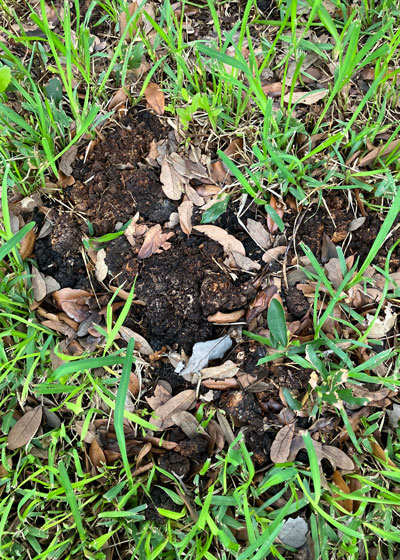
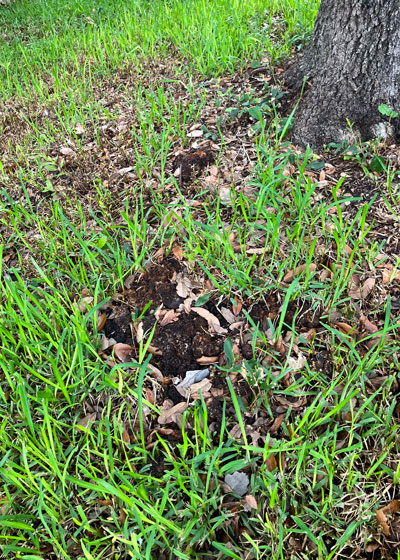
Answer: I have reached out to Russel Peters of Arborilogical Services in DFW. Russ is a former Texas Arborist of the Year, and Arborilogical Services is a longtime advertiser here in e-gardens. He suspects that this might be crown gall (Agrobacterium tumefaciens), a bacterium that attacks many genera and species of plants. To his eye, it appears that a mower may have grazed the top of the gall in the close-up photo.
I did research on crown gall in oaks and other species, and I found that it is spread by mechanical injuries (mowers, wheels, line trimmers, etc.), so avoid hitting the galls. It probably isn’t going to kill your tree when it’s on its roots like this, but you don’t want it to spread to other susceptible plants. That can happen from the contaminated soil beneath this tree.
There are many good university write-ups on crown gall on trees. This one specifically addresses oaks. In fact, it covers all the diseases that may befall our oaks. https://extension.uga.edu/publications/detail.html?number=B1286#crown
Scroll down to the section on crown gall.
I would suggest that your son retain an ISA (International Society of Arboriculture) Certified Arborist to look at this tree and, hopefully, collect samples to have cultured in a pathology laboratory. The Texas A&M Plant Disease Clinic could identify whether it is, for certain, crown gall and what he might want to do beyond what I have reported here.
QUESTION 2
SHOULD WE BAG GRASS CLIPPINGS OR MULCH THEM BACK INTO THE LAWN?
Question: We moved into a new house last July. The lawn had been completely sodded with bermuda. My old yard was St. Augustine, and it always seemed to do better if I bagged clippings each time I mowed. I still bag, but I wonder what your opinions are on bagging versus not bagging. Alvie S., Fort Worth.
Answer: You can make a case for either. Those clippings have a lot of nutrients in them, so it will help your lawn if you return them to the soil.
But that will require several things:
• You will want a dedicated mulching mower that will chop them into smaller pieces for faster breakdown.
• You will want to mow on 4- or 5-day turnarounds so the clippings are relatively short, again to speed up the decay process.
• Also, you will need to avoid fast-release fertilizers that would tend to cause a build-up of thatch on top of the ground and beneath the grass. Thatch becomes impenetrable to water and nutrients, and inexpensive, poor quality fertilizers promote thatch.
If you do decide to bag your clippings, use them in your compost. Just don’t send them to the landfill. They don’t want them. Our landfills are filling up too rapidly already and these clippings are valuable resources we should be recycling.
QUESTION 3
WHAT ABOUT USING COFFEE GROUNDS AROUND HYDRANGEAS, AZALEAS, AND HOSTAS?
Question: What do you think about using coffee grounds around hydrangeas, azaleas, and hostas? I can’t find a reference to this in your books and haven’t seen it in the newsletter. I have read such conflicting information, and I value your opinion. Betty M., Tarrant County.
Answer: Thanks for your confidence. I hope I don’t come across too strong. The pH of coffee grounds, best I could find, ranges from 6.5 to 6.8 (slightly acidic). That would be very modestly beneficial. They would also be adding organic matter, but only a small amount. Honestly, it’s much ado about almost nothing. Good compost from tree leaves and grass clippings would have a lot more to offer and would be available in greater quantity, plus it wouldn’t pack together. If you have them, by all means use them, but only in combination with other better sources of organic matter.
QUESTION 4
WHY THE DIFFERENCE IN MY HOLLY FERNS?
Question: What’s happening with my holly ferns? The darker green plant was planted only a few weeks ago. (It might have gotten too dry once.) The other plant came back from the freeze and has several green leaves, but a bunch of pure yellow ones. What is wrong with it? NG, Plano.
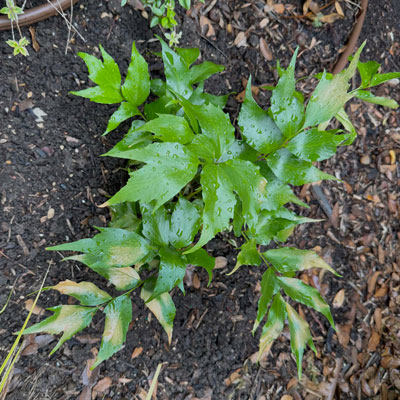
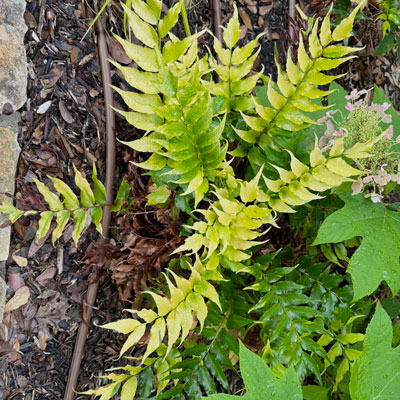
Answer: Yes, on the new plant having gotten too dry earlier. But the new growth looks great. As for the plant with the yellowed leaves, that looks like a shortage of nitrogen. I would suggest a high-nitrogen, water-soluble plant food like you would use on houseplants and hanging baskets. Apply it weekly and see if the plant doesn’t green up. That’s the way plants react to organic matter that is breaking down too rapidly. Bacteria are busily tying up the nitrogen in the soil while the plants are in hunger mode. It can happen with fresh manure, straw that hasn’t rotted, sawdust that hasn’t been composted, etc. Rare problems can also lead to it. They’re unlikely, but they would include really waterlogged soil, a gas leak, leaching from a weed-and-feed fertilizer and even, I suppose, leftover damage from the winter’s cold, although I haven’t seen holly ferns react that way to cold dieback. I live within 15 miles of you, and I use frost cloth to cover my holly ferns anytime temperatures are going to drop below 24 degrees. They remained covered for 7 or 8 weeks this year.
QUESTION 5
WHAT HAPPENED TO OUR ST. AUGUSTINE?
Question: Our St. Augustine lawn looks like a war was fought on it. We have a number of large areas with no grass at all. Two years ago it looked great. Is this a fungus? Chinch bugs? I don’t want to sod until I know why this has happened. Bob S., Highland Village, Denton County.
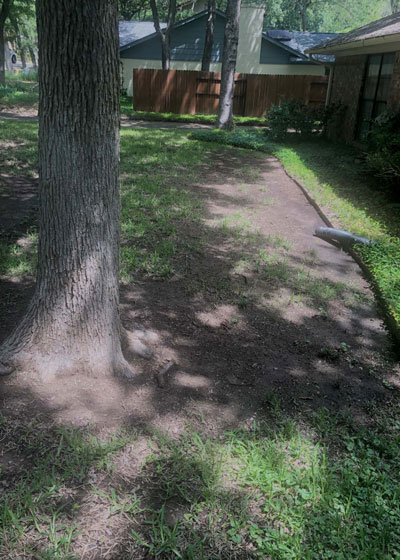
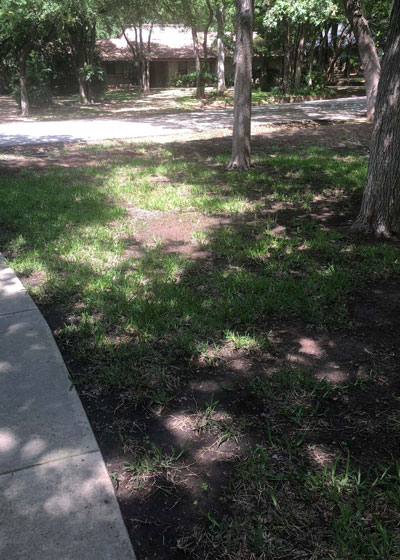
Answer: Chinch bugs will appear only in hot, baking, get-me-out-of-the full hot summer sun. Never in shade. They’re out. And, this was not caused by fungal disease of any type.
This is lack of sunlight. St. Augustine requires 5 or 6 hours of full, direct sunlight all through the growing season. Not “bright shade.” Full sunlight. You will see that the heavier the shade is in these areas, the less grass you have. We have had two very cold winters the past two years. That set the grass back even farther because it caused it to go completely dormant. It had to start over again in the spring from a dead stop. Gardeners in South Texas get a head start because St. Augustine never goes as dormant as yours does in North Texas where you live. Spending money on more sod would be a total waste of time, effort, and funds. You either have to start taking out trees (a terrible idea!) or switching over to shade-tolerant groundcovers and shrubs. I’ve walked that path before you and it’s not as discouraging as many might have you think. It’s actually a fun challenge.
QUESTION 6
WHAT FERTILIZER SHOULD I USE ON NEW ZEON ZOYSIA?
Question: I have new Zeon zoysia sod that was planted one month ago. What fertilizer should I use? Is there a certain schedule I should follow? Kendra S., Corinth.
Answer: Use a fertilizer that basically contains only nitrogen (first number of the analysis – no phosphorus, although some potassium would be fine). Hopefully you’ll find a fertilizer with 30 to 40 percent of its nitrogen in slow-release form.
Since it is a new planting, I would suggest feeding it at half rate this first time, then coming back in four weeks at the recommended rate. Then again in early September at the recommended rate. After this year, mid-April, mid-June and early September all at the rate recommended on the bag.
QUESTION 7
WHAT IS WRONG WITH MY MOM’S 80-YEAR-OLD NATIVE PECAN TREE?
Question: This is my mom’s 80-year-old native pecan tree. She said it started to leaf out like this last year. She wasn’t sure if it might be drought-related and if the tree is dying. Connie P. from West.
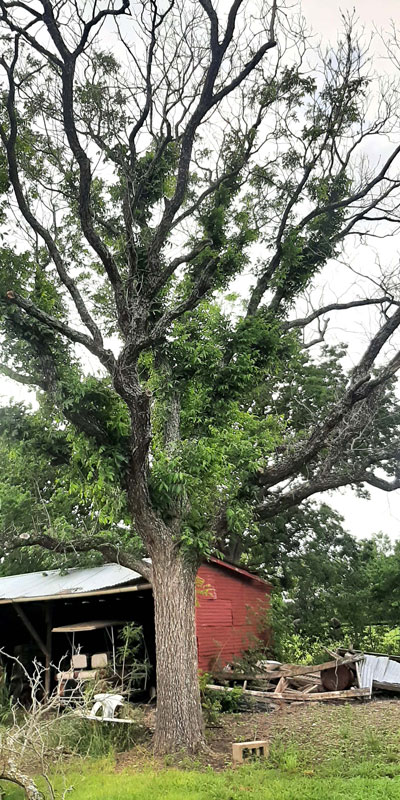
Answer: This tree is severely compromised. Damage was done, either by the cold of February 2021 or by the two extreme droughts of the last two late summers and early falls. Those dead branches are quite heavy, and they will fall under their own weight. Your mom needs to have a certified professional arborist trim and remove them. That will give you a better idea of the extent of the damage. Looking at where the vigorous regrowth is appearing my guess would be that there is active decay in the trunk. Don’t delay. Have this handled right away.
